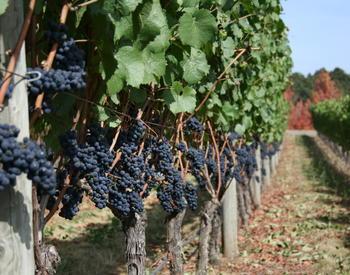Dealing with damaged fruit in the winery
During certain vintages, more fruit flies may be present in vineyards with cracked berries (typically as a result of rain). In some cases, the fruit fly larvae are present in the berries when they arrive at the winery. These larvae only survive when they have adequate oxygen and nutrients. Larvae will be killed during the fermentation period and will be removed by the settling and racking process post-fermentation without affecting wine quality.
While appearance of larvae may seem unsettling, the important issue is managing the spoilage bacteria and yeast associated with damaged berries. Damaged fruit will likely have a much higher population of certain microorganisms, such as acetic acid bacteria and oxidative yeast.
The main spoilage issue associated with acetic acid bacteria is the excessive production of acetic acid. Although we usually encounter acetic acid production during wine aging, you may actually detect an acetic aroma on damaged berries. This is due to yeast growth on the damaged berries converting grape sugars to ethanol, which the bacteria then convert to acetic acid.
The major yeast found on the berries is typically Kloeckera apiculata. This yeast is capable of producing high amounts of ethyl acetate (nail-polish remover smell) and acetaldehyde. Because of the likely increased concentrations of yeast and bacteria on the fruit, higher levels of SO2 should be added at the crusher (≥50 mg/L).
Additionally, minimizing oxygen exposure during cold soak and early fermentation will help reduce the growth of these microbes as they are both oxidative. Consider inert gas blanketing and/or dry ice addition to the surface of the fermenter to minimize oxygen. Once fermentation begins, the CO2 produced will set up an anaerobic environment that will inhibit the growth of Acetobacter and Kloeckera.
Although Acetobacter will not be growing during the alcoholic fermentation, they will still be present in the wine, so good practices in the cellar post-fermentation will be needed to prevent its growth. After alcoholic fermentation, the principal factors affecting Acetobacter growth include alcohol content, pH, SO2, and the redox potential of the wine. Acetobacter are inhibited at low pH, and at low pH more SO2 is in the free molecular form that is active against microorganisms.
One of the issues with controlling Acetobacter with SO2 is that they produce spoilage products that bind free SO2 and minimize its effectiveness. This makes early control important because these bacteria can be difficult to control at high populations.
Wines should be protected from air by filling tanks and barrels as completely as possible and ensuring barrel-topping over time. In addition, minimize air pick-up when wines with a high count of Acetobacter are being moved during racking, pumping over, fining and bottling.
An additional factor of note when dealing with damaged fruit is grape nutrient content. Microbial growth on the berries and during cold soak/early fermentation can lead to depletion of yeast assimilable nitrogen (YAN) and vitamins. In addition, the higher use of SO2 can lead to thiamin deficiency as SO2 reacts irreversible with this vitamin. Therefore, monitor YAN and make appropriate additions of organic and inorganic nitrogen (not just DAP, as this will not replace the vitamins).
In summary, consider the following tactics in dealing with damaged fruit:
- Sort fruit prior to processing.
- Increase SO2 addition at the crusher.
- Reduce or eliminate cold soaking. If you do cold soak, minimize exposure to air during cold soak (inert gas or dry ice).
- Assess YAN and make adjustment — microbial rot will reduce YAN and vitamins and SO2 use will reduce thiamin content.
- Increase vigilance in the cellar post-fermentation to prevent Acetobacter growth: pH and SO2 management, protect wine from air.

 Extension Service
Extension Service